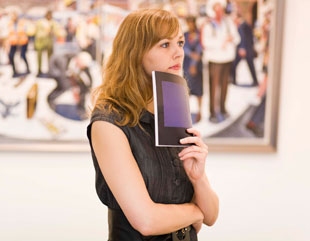It has been our experience in reviewing and recommending resources for people's spiritual journeys that there is something for everybody. We also recognize that many people relate better to images than to words. This is a not a problem because the spiritual dimension of life is evident everywhere, including in art.
We reviewed art exhibitions in New York City from 1968 through the early 1980s. It was an exciting time given all the experimentation, the different art movements, and attempts to challenge the art establishment. But we gave up reviewing art shows as our audience expanded far beyond New York. We have continued to review art books through the years.
In May 2015, with the relaunch of Spirituality & Practice, we added a section on the arts, including painting and sculpture. We explore the spiritual sides of old and new artists via book reviews, commentaries, reflections, and video clips, and we make suggestions on how you can make contemplating art part of your spiritual regimen.
What kind of art are we talking about? Here are some ways we look at art as an expression of spiritual qualities:
- Art as a grand initiator into the mysteries of life. (Consider the paintings of Mark Rothko that seem to invite us into the unknown and unexplored.)
- Art as a celebration of beauty in its many forms. (Artists often create beauty where it is not at first obvious in human bodies, objects, and the natural world.)
- Art as a teacher of paying attention and being truly present. (Think of Vincent Van Gogh's intense attention focused on a vase with sunflowers.)
- Art as a training ground for compassion and empathy. (Rembrandt's self-portraits in old age come to mind.)
- Art as an invitation to ponder the soul of things. (Think of Vermeer's women, such as The Milkmaid, with various objects.)
- Art as an expression of our yearning for love. (Victoria Moran has said: "Beauty rubs off. You can't stand in front of a Rembrandt and walk away the same person.")
- Art as a way to confront the ugly, the horrific, and the grotesque without running away. (Edvard Munch's The Scream is a good example.)
- Art as a gateway to the honest embrace of our emotions. (Art therapy is a growing field.)
- Art as an opening to mystical experiences. (Religious paintings reveal glimpses of the unseen, as do many abstract ones.)
- Art as a prophetic protest against war, oppression and poverty.
(Picasso's Guernica so graphically depicts war that it becomes a protest against it.)
- Art as a celebration of the flesh that makes nudity natural and pleasing. (Willem de Kooning said, "Flesh was the reason oil painting was invented.")
- Art as a rehearsal for the technological changes to come. (Through their imaginative works, many painters and sculptors have predicted things to come.)
- Art as a means of connecting to the natural world and all its bounties. (At a time when many people suffer from "nature deficit disorder," paintings can be a reminder of what we are missing.)
- Art as a playground for free spirits. (The creations of Red Grooms and Alexander Calder bring out the inner child in young and old alike.)
- Art as a teaching tool to raise our consciousness. (Artist Robert Rauschenberg says he wants to help people see more clearly and expand their consciousness.)
- Art as something that shakes us out of our conventional thinking. (Jean Dubuffet said, "The true aim of all art is subversive.")
- Art as a meaning maker. (Alain de Botten and John Armstrong salute the therapeutic values of art for inner growth.)
- Art as capable of transporting us into a state of reverie. (We often find ourselves transported to a different place and time just by standing in front of a painting.)
- Art as a shape-shifter that always has something new to say to us. (The best approach to an art exhibition is to have a beginner's mind, as the Buddhists put it.)
- Art as an exploration of reverence. (Paul Woodruff has said, "Art speaks the language of reverence better than philosophy.")
Zen master D. T. Suzuki has stated: "Art is studied in Japan not only for art's sake, but for spiritual enlightenment." We believe art is always connected to spirituality. It is one of the ways we come truly alive.
That is why on these pages you will see a multiversity of resources on paintings, sculpture, calligraphy, flower arrangement, mandalas, icons, symbols, stained-glass windows, sand mandalas, the face of Jesus, statues of the Buddha, enso (Zen circles), artist biographies, meditative poems accompanying art pieces, the Japanese aesthetic of wabi sabi, sacred sites, religious art, shamanic paintings, rock paintings, and much more. May our explorations of the spiritual dimensions of art support your own creative quests and expressions.
